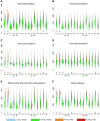Cutaneous Arsenical Exposure Induces Distinct Metabolic Transcriptional Alterations of Kidney Cells
- PMID: 37699712
- PMCID: PMC10801764
- DOI: 10.1124/jpet.123.001742
Cutaneous Arsenical Exposure Induces Distinct Metabolic Transcriptional Alterations of Kidney Cells
Abstract
Arsenicals are deadly chemical warfare agents that primarily cause death through systemic capillary fluid leakage and hypovolemic shock. Arsenical exposure is also known to cause acute kidney injury, a condition that contributes to arsenical-associated death due to the necessity of the kidney in maintaining whole-body fluid homeostasis. Because of the global health risk that arsenicals pose, a nuanced understanding of how arsenical exposure can lead to kidney injury is needed. We used a nontargeted transcriptional approach to evaluate the effects of cutaneous exposure to phenylarsine oxide, a common arsenical, in a murine model. Here we identified an upregulation of metabolic pathways such as fatty acid oxidation, fatty acid biosynthesis, and peroxisome proliferator-activated receptor (PPAR)-α signaling in proximal tubule epithelial cell and endothelial cell clusters. We also revealed highly upregulated genes such as Zbtb16, Cyp4a14, and Pdk4, which are involved in metabolism and metabolic switching and may serve as future therapeutic targets. The ability of arsenicals to inhibit enzymes such as pyruvate dehydrogenase has been previously described in vitro. This, along with our own data, led us to conclude that arsenical-induced acute kidney injury may be due to a metabolic impairment in proximal tubule and endothelial cells and that ameliorating these metabolic effects may lead to the development of life-saving therapies. SIGNIFICANCE STATEMENT: In this study, we demonstrate that cutaneous arsenical exposure leads to a transcriptional shift enhancing fatty acid metabolism in kidney cells, indicating that metabolic alterations might mechanistically link topical arsenical exposure to acute kidney injury. Targeting metabolic pathways may generate promising novel therapeutic approaches in combating arsenical-induced acute kidney injury.
Copyright © 2024 by The American Society for Pharmacology and Experimental Therapeutics.
Figures




Similar articles
-
Cutaneous exposure to lewisite causes acute kidney injury by invoking DNA damage and autophagic response.Am J Physiol Renal Physiol. 2018 Jun 1;314(6):F1166-F1176. doi: 10.1152/ajprenal.00277.2017. Epub 2018 Jan 17. Am J Physiol Renal Physiol. 2018. PMID: 29361668 Free PMC article.
-
Protective role of HO-1 against acute kidney injury caused by cutaneous exposure to arsenicals.Ann N Y Acad Sci. 2020 Nov;1480(1):155-169. doi: 10.1111/nyas.14475. Epub 2020 Sep 3. Ann N Y Acad Sci. 2020. PMID: 32885420 Free PMC article.
-
PPAR alpha ligand protects during cisplatin-induced acute renal failure by preventing inhibition of renal FAO and PDC activity.Am J Physiol Renal Physiol. 2004 Mar;286(3):F572-80. doi: 10.1152/ajprenal.00190.2003. Epub 2003 Nov 11. Am J Physiol Renal Physiol. 2004. PMID: 14612380
-
Dietary glycation compounds - implications for human health.Crit Rev Toxicol. 2024 Sep;54(8):485-617. doi: 10.1080/10408444.2024.2362985. Epub 2024 Aug 16. Crit Rev Toxicol. 2024. PMID: 39150724
-
Transcriptional regulation of proximal tubular metabolism in acute kidney injury.Pediatr Nephrol. 2023 Apr;38(4):975-986. doi: 10.1007/s00467-022-05748-2. Epub 2022 Oct 1. Pediatr Nephrol. 2023. PMID: 36181578 Review.
Cited by
-
Progress and Challenges in Developing Medical Countermeasures for Chemical, Biological, Radiological, and Nuclear Threat Agents.J Pharmacol Exp Ther. 2024 Jan 17;388(2):260-267. doi: 10.1124/jpet.123.002040. J Pharmacol Exp Ther. 2024. PMID: 38233227 Free PMC article.
-
Chronic kidney disease amplifies severe kidney injury and mortality in a mouse model of skin arsenical exposure.Am J Physiol Renal Physiol. 2025 Mar 1;328(3):F328-F343. doi: 10.1152/ajprenal.00139.2024. Epub 2024 Oct 17. Am J Physiol Renal Physiol. 2025. PMID: 39417795 Free PMC article.
References
-
- Cargill K, Sims-Lucas S (2020) Metabolic requirements of the nephron. Pediatr Nephrol 35:1–8. - PubMed
Publication types
MeSH terms
Substances
Grants and funding
LinkOut - more resources
Full Text Sources
Molecular Biology Databases
